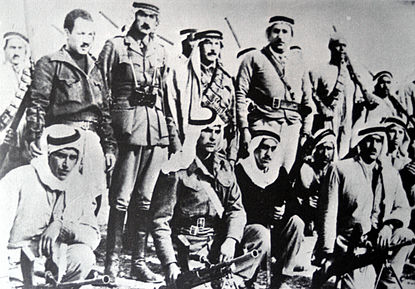| Army of the Holy War | |
|---|---|
| جيش الجهاد المقدس Jaysh al-Jihād al-Muqaddas | |
| Leaders | Abd al-Qadir al-Husayni Hasan Salama |
| Foundation | December 1947 |
| Dates of operation | 1947–1948 |
| Dissolved | May 1949 |
| Country | |
| Headquarters | Bir Zeit, Palestine |
| Active regions | Mandatory Palestine |
| Ideology | Palestinian nationalism Arab nationalism Pan-Arabism Anti-Zionism Islamism |
| Size | At least 1,306 |
| Allies | |
| Opponents | Yishuv |
| Battles and wars | 1947–1948 civil war in Mandatory Palestine 1948 Arab-Israeli War |
The Army of the Holy War or Holy War Army (Arabic: جيش الجهاد المقدس; Jaysh al-Jihād al-Muqaddas) was a Palestinian Arab irregular force in the 1947–1948 civil war in Mandatory Palestine led by Abd al-Qadir al-Husayni and Hasan Salama. The force has been described as Husayni's "personal" army. The Arab League set up the Arab Salvation Army (Jaysh al-Inqadh al-Arabi) as a counter to the Army of the Holy War while, in practice, the Arab governments prevented thousands of volunteers from joining either force.
Abd al-Qadir al-Husayni arrived in the Jerusalem sector in December 1947 and by March 1948 had about 128 men. He established his headquarters at Bir Zeit and started to conduct a blockade of Jerusalem by attacking the Jewish convoys to the city. Hasan Salama, with 950 men of the Jihad and 228 irregulars, took responsibility for the operations in the Lydda and Ramle sectors, at the entry of the Tel Aviv-Jerusalem road.
The Army of the Holy War had over 50,000 Palestinian Arabs available for local defense but a force of only 5,000 to 10,000, both foreign fighters from Arab states and Palestinian Arab militiamen, available to be sent where needed during the 1947–1949 Palestine war.
Husayni was killed during the battle for control of Qastal Hill on the Tel Aviv-Jerusalem road, on 8 April 1948. His forces captured Qastal from the Haganah, which had occupied the village at the start of Operation Nachshon six days earlier with a force of about 100 men. They retreated to the Jewish settlement of Motza. Palmach troops recaptured the village on the night of 8–9 April; most of the houses were blown up and the hill became a command post. Husayni's death was a factor in the loss of morale among his forces.
When the All-Palestine Protectorate was formed on 22 September 1948, during the 1948 Arab-Israeli War, it revived the Holy War Army, with the declared aim of "liberating Palestine". However, the government had no money of its own, and operated only under the supervision of Egypt, and was generally ineffective.
In October 1948, Jordan gave an order to its forces, the Arab Legion, to surround and forcibly disarm various units of the Holy War Army.
|
Notes
- Lebanon had decided to not participate in the war and only took part in the battle of al-Malikiya on 5–6 June 1948.
References
- Rosen, David M. (2005). Armies of the Young: Child Soldiers in War and Terrorism. Rutgers University Press. ISBN 978-0-8135-3568-5.
- Cummins, Joseph (2009). The War Chronicles: From Flintlocks to Machine Guns. Fair Winds Press. ISBN 978-1-61673-404-6.
- Herf, Jeffrey (2014). "Haj Amin al-Husseini, the Nazis and the Holocaust: The Origins, Nature and Aftereffects of Collaboration". Jewish Political Studies Review. 26 (3/4): 13–37. JSTOR 43922000.
- Litvak, Meir (1998). "The Islamization of the Palestinian-Israeli Conflict: The Case of Hamas". Middle Eastern Studies. 34 (1): 148–163. doi:10.1080/00263209808701214. JSTOR 4283922.
- ^ Oren 2003, p. 5.
- Morris (2008), p. 260.
- Gelber, pp. 55, 200, 239
- Morris, Benny (2008), 1948: The First Arab-Israeli War, Yale University Press, p.205, New Haven, ISBN 978-0-300-12696-9.
- Hourani, 2004, p. 537.
- Pappé, 1994, p. 65.
- Sayigh, 1999, p. 14.
- Khalaf, 1991, p. 207.
- Morris, 2008, p. 107.
- Dupuy (1978) p. 41.
- Morris, 2003, p. 234.
- Dana Adams Schmidt, "Arabs Win Kastel But Chief is Slain", The New York Times, 9 April 1948, p. 8 (A brief biography and account of the battle).
- Benveniśtî, 2002, p.111.
- Morris, 2003, p. 235.
- Time, "War for Jerusalem Road", April 19, 1948
- Simon, Mattar and Bulliet, 1996, p. 114.
Bibliography
- Benveniśtî, Mêrôn (2002). Sacred Landscape: The Buried History of the Holy Land Since 1948. University of California Press. ISBN 0-520-23422-7
- Gelber, Yoav (1997). Jewish-Transjordanian Relations 1921–48: Alliance of Bars Sinister. London: Routledge. ISBN 978-0-7146-4675-6
- Gelber, Yoav (2004). Israeli-Jordanian Dialogue, 1948–1953: Cooperation, Conspiracy, or Collusion?. Sussex Academic Press.
- Gelber, Yoav (2004) Independence Versus Nakba; Kinneret Zmora-Bitan Dvir Publishing, ISBN 965-517-190-6
- Gelber, Yoav (2006). Palestine 1948: War, Escape and the Emergence of the Palestinian Refugee Problem. Sussex Academic Press. ISBN 978-1-84519-075-0
- Hourani, Albert Habib, Philip S. Khoury, and Mary C. Wilson.(2005). The Modern Middle East: A Reader. London: I.B. Tauris. ISBN 978-1-86064-963-9
- Khalaf, Issa. (1991). Politics in Palestine: Arab Factionalism and Social Disintegration, 1939-1948. Albany: State University of New York Press. ISBN 978-0-7914-0707-3
- Morris, Benny (2003). The Birth of the Palestinian Refugee Problem Revisited. Cambridge University Press. ISBN 0-521-00967-7
- Morris, Benny (2008). 1948: A History of the First Arab-Israeli War. Yale University Press. ISBN 978-0-300-12696-9
- Oren, Michael, Six Days of War, Random House Ballantine Publishing Group, (New York 2003, ISBN 0-345-46192-4
- Pappé, Ilan. (1994). The Making of the Arab-Israeli Conflict, 1947-51. London: I.B. Tauris. ISBN 978-1-85043-819-9
- Ṣāyigh, Yazīd Yūsuf. (1999). Armed Struggle and the Search for State: The Palestinian National Movement, 1949-1993. Oxford: Clarendon Press. ISBN 978-0-19-829643-0
- Simon, Reeva S., Philip Mattar, Richard W. Bulliet (1996). Encyclopedia of the Modern Middle East 1, A - C. New York: Macmillan Reference. ISBN 978-0-02-896011-1
- Dupuy, N. Trevor (1978). Elusive Victory—The Arab-Israeli war 1947–1974, New York, N.Y. 10022. ISBN 0-06-011112-7



